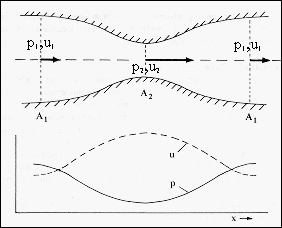|
|||||||||||||||
|
|
|||||||||||||||
|
|
|
|||||||||||||
| The
diagram shows a flow through a duct of variable area. The center line of
the duct is horizontal and the change in potential energy is zero over
the region. Bernoulli's equation gives:
(rV2/2)
+ p = p0, or:
(p0 - p) = (rV2/2),
and relates the pressure, p, at each location to the corresponding fluid
velocity, u. The pressure, p,
is the pressure in the flow and is known as the "static pressure." The
pressure, p0,
is the constant total energy per unit volume in the flow and is known as
the "stagnation pressure." The term (rV2/2)
is identified as the "dynamic pressure" so that for the flow:
Static Pressure + Dynamic Pressure = Stagnation Pressure The graph shown below the duct diagram indicates how the static pressure anti-correlates with the flow speed, u. An increase in the speed of the incompressible flow causes a decrease in the static pressure of the flow and visa versa. The stagnation pressure is independent of flow speed. Although this example has used flow in a duct, the same conclusion holds for flow in a streamtube. Looking at the streamtube for the flow over the top of the wing in the smoke tunnel photographs shows that its area decreases and hence the flow accelerates. The pressure in this region is therefore lower than the pressure below the wing. |
|||||||||||||||
 |
|||||||||||||||
| From:
Wegener,
"What Makes Airplanes Fly?" Springer-Verlag (1991) |
|||||||||||||||